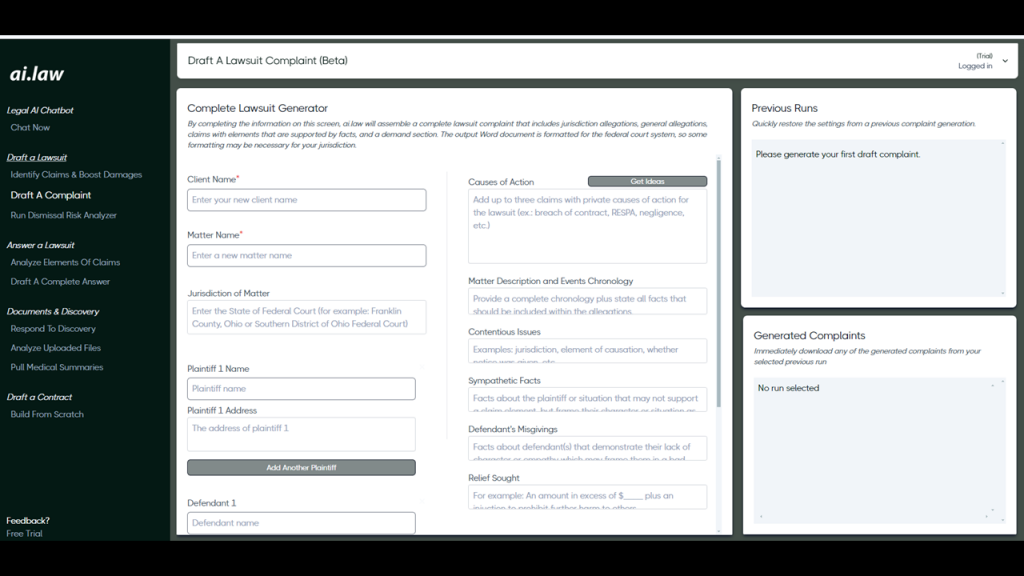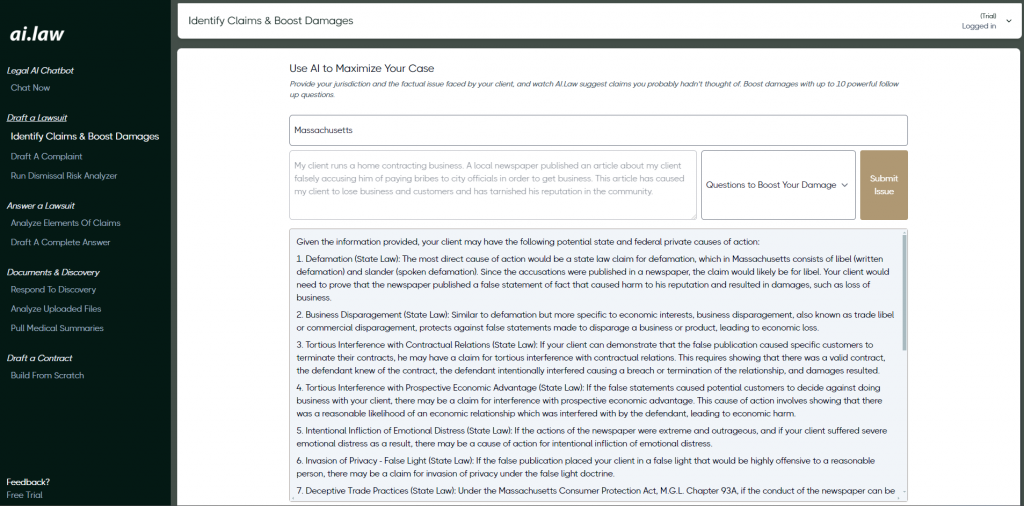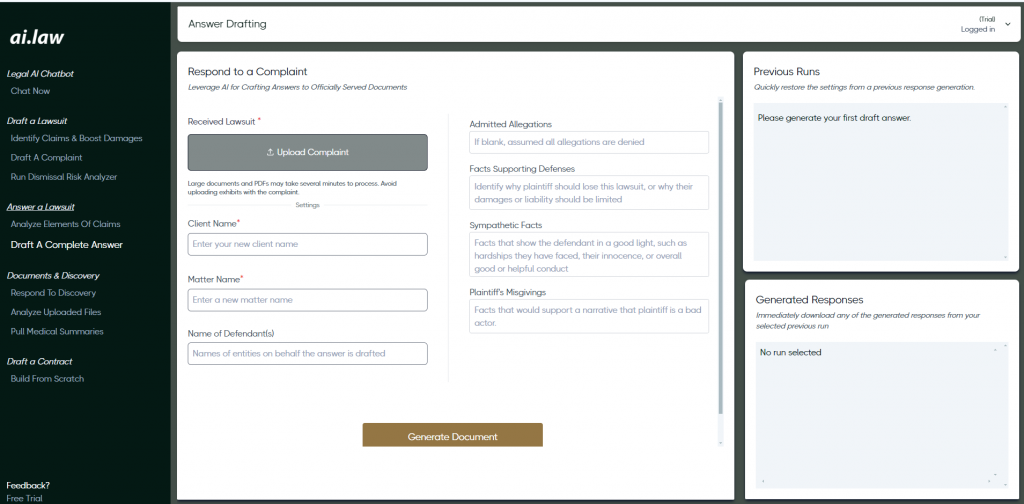Ai.law, a legal technology startup that uses artificial intelligence to generate litigation documents, has added a new module that will draft the complaint to initiate a lawsuit.
While Ai.law already had modules for litigation tasks such as answering a lawsuit, responding to discovery, and pulling summaries from medical records, this new module allows a user to input relevant information about a case and generate a complete complaint.
The draft complaints include jurisdictional allegations, general allegations, claims with elements that are supported by facts, and a demand section.
The product, which is in beta, generates a Microsoft Word document formatted for the federal court system. Users in state courts will have to customize the formatting to fit local requirements.
In addition to drafting a complaint, Ai.law can also suggest legal claims you may want to include in your lawsuit or ways to potentially boost the damages you could recover, based on the specific jurisdiction and facts of your case.
Generating A Complaint
To draft a complaint, you fill out a form with specific information about the case. In addition to the names of the parties and the jurisdiction, Ai.law asks you to provide:
- Causes of action. (If you need help, you can click to open the tool that suggests claims based on your facts.)
- A description of the matter and chronology of events.
- Any issues likely to be contentious.
- Facts sympathetic to your client.
- Defendant’s misgivings, meaning any facts that might demonstrate the defendant’s lack of character or empathy.
- The relief sought.
- Any other special instructions.
Once those fields are complete, simply click “Generate Complaint,” and in a few moments a Word document is downloaded to your computer in the form of a complete complaint.
It should be unnecessary to say, but no lawyer should ever accept this output and file it with a court without first carefully reviewing and revising it. As noted above, you may also need to adapt its formatting to fit the requirements of the court where you will file it.
Ai.law suggests you may want to also run the draft complaint through its Dismissal Risk Analyzer to test for the sufficiency of the allegations.
Giving It A Try
More for fun than an in-depth test, I gave it a whirl, describing to Ai.law a made-up factual scenario in which a local newspaper published a story about a local building contractor alleging that he had bribed municipal officials in return for preferential treatment in awarding contracts.
Based on the fairly minimal information I provided, the application generated a complaint that included counts for defamation, business disparagement, tortious interference with contractual relations, and invasion of privacy.
You can read the complaint it generated here.
Overall, the complaint it generated was, at least on its face, a good first draft. Of course, I would need to research the elements of the various claims and determine whether more needed to be said or if any should be deleted, but even just the drafting could be a real time saver.
I also found the language, primarily in the introduction, to be a bit melodramatic. This opening paragraph is an example:
“In the heart of Boston, where trust and reputation are the cornerstones of local business, John Smith stands as a paragon of integrity, unjustly maligned by the reckless words of the Boston Beacon. Smith Contracting, a business built on the bedrock of honest work and community service, has been thrust into the shadow of scandal by a story as false as it is damaging. Despite John Smith’s unblemished record of service and his role as a pillar of the community—evidenced by his membership in the Chamber of Commerce and his dedication as a Little League coach—the Boston Beacon has callously sullied his name without regard for the truth.”
But some may like that style, and for those of us who do not, some simple editing would easily tone it down. In an email, Troy Doucet, the litigator who founded Ai.law, conceded the language could be “a bit fluffy,” but said it would be toned down over time.
Analyzing the Complaint
After I used Ai.law to generate a complaint, I turned the tables, uploading the complaint it generated and, using its “Analyze Elements of Claims” feature, asking it to analyze the sufficiency of the allegations and the elements of the claims.
For each claim in the complaint, it described the elements that must be established and then indicated whether the complaint addressed each of those elements.
For example, with respect to the defamation claim, Ai.law said that one element of the claim is showing the defamatory character of the publication. “The statement must tend to harm the reputation of the plaintiff,” the AI said. “The article’s allegations are clearly defamatory as they accuse the plaintiff of criminal activity.”
But with respect to the claim of invasion of privacy, the AI said that one element, public disclosure of private facts, was not met in the complaint. “The disclosed facts must be private and not of public concern,” it explained. “The lawsuit does not clearly establish this element, as it does not detail what private facts were disclosed, though it suggests the article was not a matter of public concern.”
I have not spent any time evaluating the legal accuracy of Ai.law’s ability to identify claims and analyze elements of a claim. But I will say again that no lawyer should rely on any AI tool to the exclusion of conducting your own research and analysis of the legal and factual issues.
But as a tool to generate a first draft, it could potentially save you time, and is at least worth giving a try.
Free to Try
If you are curious to try Ai.law’s complaint generator for your yourself — or any of its AI applications — the company offers a free trial. After the free trial ends, it offers three tiers of monthly subscriptions, ranging from $209 to $649, depending on features and usage levels.
By the way, the year-old company was one of the 15 startups that competed in this year’s Startup Alley at ABA TECHSHOW.



